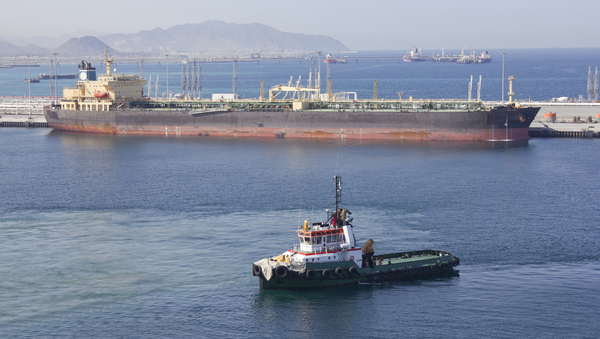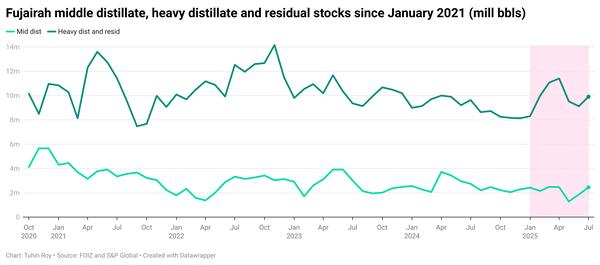East of Suez Market Update 21 Jul 2025
Prices in East of Suez ports have moved down, and bunkering has been suspended today in Zhoushan’s OPL area due to rough weather.
 IMAGE: Aerial view of Zhoushan City, Zhejiang Province. Getty Images
IMAGE: Aerial view of Zhoushan City, Zhejiang Province. Getty Images
Changes on the day from Friday, to 17.00 SGT (09.00 GMT) today:
- VLSFO prices down in Zhoushan ($14/mt), Fujairah ($13/mt) and Singapore ($10/mt)
- LSMGO prices down in Fujairah ($17/mt), Zhoushan ($7/mt) and Singapore ($6/mt)
- HSFO prices down in Zhoushan ($11/mt), Singapore and Fujairah ($7/mt)
- B24-VLSFO at a $176/mt premium over VLSFO in Singapore
- B24-VLSFO at a $238/mt premium over VLSFO in Singapore
Zhoushan’s VLSFO price dropped by $14/mt over the weekend—the sharpest decline among the three major Asian bunker ports. Despite the decrease, Zhoushan’s VLSFO still stands at a premium of $13/mt over Fujairah and $4/mt over Singapore.
VLSFO supply in Zhoushan remains stable amid subdued demand, with most suppliers quoting lead times of around 6–7 days, largely unchanged from six days the previous week. HSFO also requires a lead time of approximately 6–7 days, similar to last week's roughly six days. LSMGO lead times remain steady as well, hovering around 6–7 days.
Bunker operations at Zhoushan’s outer anchorages—Tiaozhoumen and Xiazhimen—have been suspended today due to adverse weather conditions. However, most suppliers expect full bunkering operations in the OPL area to resume after 25 July, a source noted.
In Taiwan, lead times for VLSFO and LSMGO at the ports of Kaohsiung and Taichung are around three days, nearly the same as last week. At other key ports like Hualien and Keelung, lead times are shorter, typically about two days.
Brent
The front-month ICE Brent contract has declined by $1.13/bbl on the day from Friday, to trade at $68.91/bbl at 17.00 SGT (09.00 GMT).
Upward pressure:
Oil has retained some ground after official drilling figures showed a decline in US oil rigs. The total number of oil rigs fell by two over the week to 422, according to Baker Hughes.
“Despite oil prices having been more stable in recent weeks, the US oil rig count continues to fall,” two analysts from ING Bank noted.
The US oil rig count is seen as an indicator of future oil production. It reflects how much oil drilling activity is happening or expected to happen in the shale sector.
In a tight market, any signal of reduced future supply can put upward pressure on Brent’s price.
“This is the 12th consecutive week of declines, taking the cumulative decline to 53 over this period,” said ING analysts.
Downward pressure:
Brent’s price has moved lower as market participants showed little reaction to the EU’s latest sanction package against Russia.
Last week, the European Union (EU) adopted the 18th package of economic sanctions against Russia, aimed at limiting oil revenues flowing to its war chest.
The EU has targeted 105 vessels that are allegedly a part of the Russia's shadow fleet used to circumvent the price caps set on Russian crude and oil products. It has also lowered the oil price cap for Russian crude from $60/bbl to $47.60/bbl.
“Oil barely blinked at the EU’s latest attempt to tighten the screws on Russian energy,” said SPI Asset Management managing partner Stephen Innes.
The sanctions will come into force on 3 September.
By Tuhin Roy and Aparupa Mazumder
Please get in touch with comments or additional info to news@engine.online

Contact our Experts
With 50+ traders in 12 offices around the world, our team is available 24/7 to support you in your energy procurement needs.




